The SAMA5D3 series MPU, based on the ARM Cortex-A5 core, increases performance while reducing power consumption, and offers strong usability and security, making it very suitable for popular applications such as human-computer interaction, M2M, and smart grids. The Atmel SAMA5D3 Xplained is another masterpiece based on this SAMA5D3 series MPU.
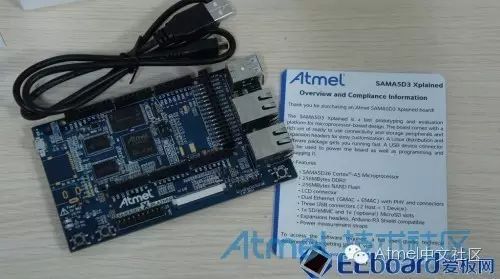
SAMA5D3 Xplained Development Board
The SAMA5D3 Xplained has a compact and exquisite appearance, unlike the rather large MYD-SAMA5D21 development board from Mill Technology, the SAMA5D3 Xplained is only 125mm x 75mm in size, even smaller than the Samsung Note 3 series phones available on the market. However, the limited space restricts the PCB layout, which is why the SAMA5D3 Xplained has 10 layers. It sounds a bit overwhelming for a development board; smartphones based on MediaTek’s true octa-core MTK6592 solution (such as Huawei and Redmi Note series) generally use 8-layer or 10-layer boards, which gives a rough idea of the rich expandability of the SAMA5D3 Xplained. The board itself has very few accessories, only a micro USB cable, which serves as a 5V power supply and is used for serial communication and downloading. According to the documentation, the board can be powered through the computer’s USB HOST interface, which at least indicates that the power consumption is relatively low. However, the SAMA5D3 Xplained development board has also reserved a DC adapter socket that has not been soldered; this may be a compatibility design for future expansion modules in case the input current is insufficient. There are also several other unsoldered areas on the board, such as the TF card slot next to the power adapter socket and several unsoldered components on the back of the board (which will be mentioned later), all of which leave space for board expansion. Now, let’s take a look at the specific onboard resources of the SAMA5D3 Xplained development board.
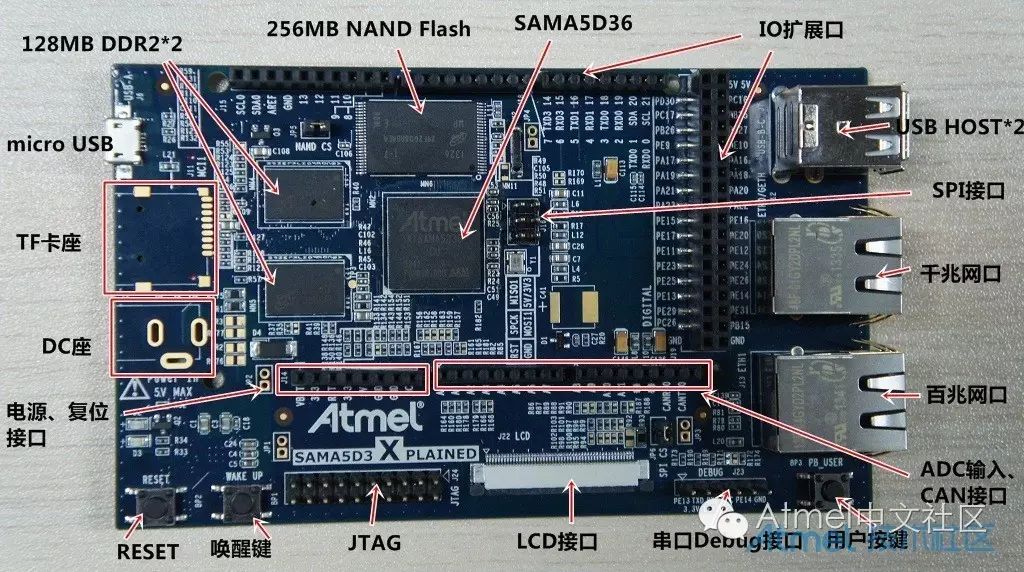
Front of the SAMA5D3 Xplained Development Board
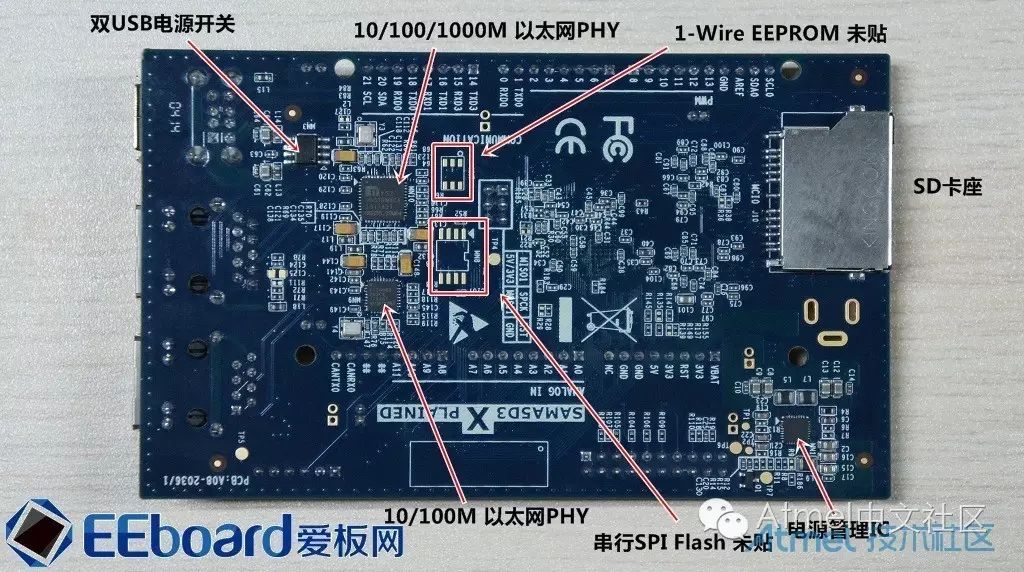
Back of the SAMA5D3 Xplained Development Board
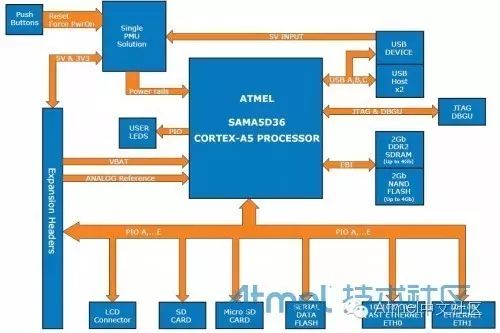
Hardware Block Diagram of the SAMA5D3 Xplained Development Board
Onboard Resources:
-
SAMA5D36 Cortex-A5 MPU, up to 536MHz clock speed
-
256MB DDR2, 256MB NAND Flash; serial FLASH and 1-WIRE EEPROM (not soldered)
-
LCD connector, dual Ethernet ports (100M + Gigabit); one SD card slot, one micro SD card interface (not soldered)
-
3 USB ports (2 HOST, 1 Device), expansion IO ports, compatible with Arduino R3 Shield
-
One standard JTAG interface, one serial DEBUG interface, three mechanical buttons (User, Wake, Reset)
MPU ATSAMA5D36 Of course, the thoughtful design of the board in terms of functionality and power consumption reflects confidence in the core controller. According to Atmel’s official introduction, the SAMA5D3 series MPU can provide processing capabilities of up to 536MHz (850 DMIPS) with a power consumption of less than 150mW. Next, let’s focus on this high-performance, low-power MPU SAMA5D36 on the board.
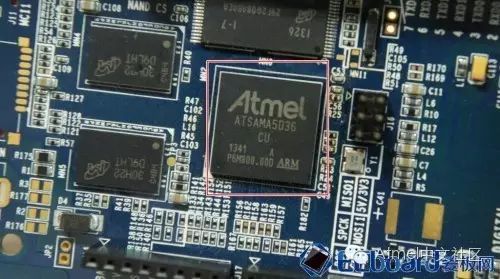 ATSAMA5D36 Microcontroller
ATSAMA5D36 Microcontroller
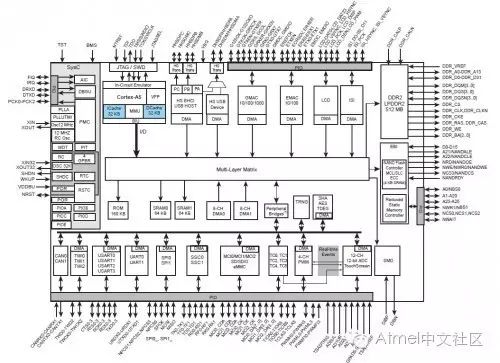 ATSAMA5D36 Microcontroller System Block Diagram
ATSAMA5D36 Microcontroller System Block Diagram
The SAMA5D3 Xplained development board is equipped with the highest specification product in the Atmel SAMA5D3 series, the SAMA5D36 (the differences between the series can be seen in the table below), based on the ARM Cortex-A5 core, with a maximum clock speed of 536MHz, a size of 12mm x 12mm, and a 324-ball BGA package. It integrates commonly used functions such as dual Ethernet MAC, LCD controller, dual CAN, USB controller, and reserves many IO ports for DIY projects, making it quite flexible.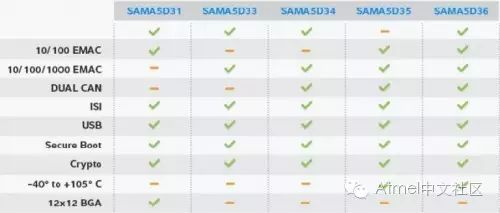 SAMA5D3 Series MPU
SAMA5D3 Series MPU
When you simply compare the SAMA5D3 series with the SAM9X series MPU, you will find that the SAMA5D3 series supports a higher 32-bit DDR width, adds support for a Gigabit Ethernet MAC controller, and supports an LCD controller and ISI, with LCD display resolution increased to 720p. In contrast, the SAM9X series only supports a 16-bit DDR width (which is still usable in slower upgrade fields like industrial control, or some low-end routers that may still be in use, basically belonging to the edge of obsolescence). It only has a 100M Ethernet MAC and does not support many functions that seem outdated, such as the LCD controller across the entire series. What reassures users is that the SAMA5D36 maintains 100% compatibility in terms of instructions and functions with higher performance Cortex-A8, A9, A15 series while improving performance and reducing power consumption, along with the security features of the Cortex-A5 processor, such as the well-known TrustZone, a secure encryption engine, and secure hash algorithms, combined with Atmel’s extensive ecosystem, whether in functionality, performance, energy efficiency, cost, or security, the SAMA5D3 gives you a reason to upgrade.
Other Hardware Parts of the SAMA5D3 Xplained:
-
Hybrid design of Gigabit Ethernet and a 100M Ethernet port
-
The power management section on the back is equipped with ACTIVE-semi’s ACT8865 PMU
Conclusion:
Overall, I give a high evaluation of the Atmel SAMA5D3 series MPU, in terms of performance and energy efficiency, the design of the SAMA5D3 Xplained development board jointly promoted by three major manufacturers: Atmel, Element14, and Intel may surprise some, but whether in workmanship or in the customizable DIY functionality, it is impeccable. The 10-layer board (rare in development boards), based on the Cortex-A5 processor (there are not many products based on the ARM A5 core available on the market), outperforms Classic ARM processors in terms of performance and energy efficiency, while also having obvious advantages in system cost and security. Coupled with Atmel’s extensive ecosystem, it is simply a favorite among geeks and developers. Those who love challenges can give it a try.
